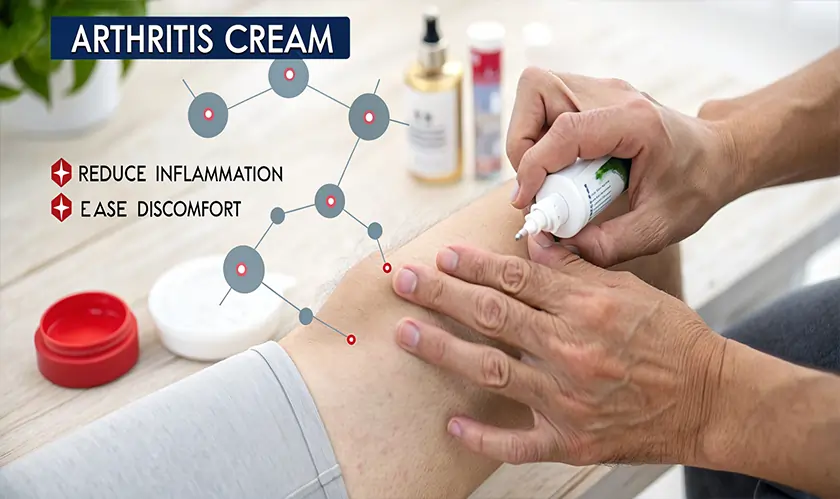Home Industry Healthcare How Does Arthritis Cream Work ...
Healthcare

CIO Bulletin
06 October, 2025
Arthritis creams provide a simple way to target joint pain without swallowing another pill. These products work on the surface of the skin, delivering ingredients that either reduce inflammation, block pain signals, or create a cooling or warming effect that distracts from discomfort. They relieve joint pain by allowing active ingredients to absorb through the skin and act directly on the painful area.
Because the medicine works closest to the surface, these creams often help with joints like the hands and knees. Some formulas use anti-inflammatory drugs, while others rely on natural compounds such as capsaicin or menthol. Each type works in a slightly different way, but the goal remains the same: to reduce pain so that daily movement feels easier.
For many people, arthritis creams provide a practical option, especially if oral pain medicine causes side effects or cannot be used long-term. Understanding how these products work, what ingredients they contain, and how to use them safely can help you determine if they are a suitable addition to a joint pain relief plan.
How Arthritis Creams Relieve Joint Pain
Arthritis creams work at the surface level of the body to ease discomfort in joints and muscles. They target pain directly at the site instead of spreading through the bloodstream, which makes them useful for people who want focused relief with fewer whole-body effects.
Types of Arthritis Creams and Gels
There are several categories of arthritis creams, each made to relieve pain in different ways. Counterirritant creams use menthol or camphor to create a cooling or warming sensation. Analgesic creams contain ingredients that directly reduce the feeling of pain. Anti-inflammatory gels often include nonsteroidal drugs that lower swelling in the joint.
Some products combine these approaches to provide broader relief. For example, a cream may include both menthol for quick soothing and an anti-inflammatory agent for longer-lasting effects.
People often choose a type based on the location of pain, sensitivity to ingredients, and how quickly they want relief. A topical option like cream for arthritis can be applied directly where discomfort is most noticeable. Additionally, some may prefer oral medications for their longer-lasting effects, especially if the pain is widespread. The choice ultimately depends on personal preferences and the specific nature of the pain being treated.
Mechanism of Action: How Topical Ingredients Work
Topical arthritis creams act on nerve endings in the skin and surrounding tissues. The ingredients absorb through the skin and either block pain signals or reduce inflammation in the affected joint.
Some creams create a warming or cooling effect, which distracts the brain from pain. Others reduce the production of inflammatory chemicals that cause swelling and stiffness.
Because the cream works locally, it tends to be most effective on joints close to the skin surface, such as knees, hands, and elbows. This targeted action makes it a practical choice for people dealing with mild to moderate joint pain.
Key Ingredients and Their Effects
Several active ingredients are commonly used in arthritis creams. Menthol and camphor create cooling or warming sensations that help mask pain. Capsaicin, derived from chili peppers, reduces pain by lowering the amount of a chemical called substance P, which transmits pain signals.
Salicylates work by reducing inflammation, making them useful for sore joints. Diclofenac, a nonsteroidal anti-inflammatory drug, is often found in gels and has been shown to reduce swelling and stiffness.
Each ingredient targets pain in a slightly different way, so the choice depends on the person’s symptoms and tolerance. Some may prefer a fast-acting cooling effect, while others may need stronger anti-inflammatory support.
Comparison to Oral Pain Relievers
Unlike oral medications, topical creams act only on the area where they are applied. This localized effect reduces the chance of side effects such as stomach irritation, which is common with oral anti-inflammatory drugs.
However, oral medicines may provide broader relief for people with widespread arthritis pain. They circulate through the bloodstream, which can help with multiple joints at once.
Topical creams are often a good first step for mild or moderate discomfort, especially in joints near the skin. Oral medicines may be added if pain persists or affects deeper joints like the hips or shoulders.
Active Ingredients and Safety Considerations
Arthritis creams use different active ingredients that target joint pain in specific ways. Some reduce inflammation directly, while others distract the nerves or dull the sensation on the skin. Each type has unique benefits and possible risks that people should understand before regular use.
Topical NSAIDs: Voltaren, Diclofenac, and Others
Topical nonsteroidal anti-inflammatory drugs (NSAIDs) reduce pain by lowering inflammation in the affected joint. Diclofenac, found in products such as Voltaren Arthritis Pain gel, is the most common example. These creams are often used for osteoarthritis in the knees, hands, and other joints close to the skin.
Unlike oral NSAIDs, which can irritate the stomach or cause ulcers, topical forms act mainly at the site of application. This reduces the chance of stomach upset, though some absorption into the bloodstream can still occur.
Doctors often recommend topical NSAIDs for people who cannot tolerate oral versions. They may also be safer for older adults or those with a history of digestive issues. However, long-term or heavy use can still carry risks for the kidneys, liver, or heart, so medical guidance is important.
Counterirritants: Menthol, Camphor, and Capsaicin
Counterirritants do not reduce inflammation directly. Instead, they create sensations such as cooling, warming, or tingling that distract the brain from deeper joint pain. Menthol and camphor provide a cooling effect, while capsaicin produces a mild burning or warming feeling.
Capsaicin works by depleting a substance in nerve endings called substance P, which helps transmit pain signals. With repeated use, this can lower pain intensity over time, though it may take several days before noticeable relief occurs.
Menthol and camphor creams act faster but usually provide shorter-term comfort. These ingredients are often combined with other agents to improve the overall effect. Some people prefer them for quick relief during flare-ups, while others use them daily to manage ongoing discomfort.
Salicylates and Lidocaine-Based Creams
Salicylates are related to aspirin and can reduce pain by blocking certain pain signals in the nerves. They may be useful for mild joint pain, though their effect is usually less strong than that of topical NSAIDs. People sensitive to aspirin should avoid these products to prevent allergic reactions.
Lidocaine-based creams work differently. They numb the skin and surrounding tissue by blocking nerve activity. This can be helpful for sharp or burning pain that sometimes comes with arthritis.
Both salicylates and lidocaine are often found in over-the-counter options. However, combining them with other pain-relieving ingredients may increase the chance of side effects, especially if applied over large areas of skin.
Potential Side Effects and Usage Precautions
Most arthritis creams cause only mild skin irritation, such as redness, rash, or itching. These effects often fade after continued use, but they may force some people to stop treatment.
Systemic side effects are less common but still possible. For example, topical NSAIDs can affect the stomach, kidneys, or heart if enough medication enters the bloodstream. Capsaicin may cause burning or stinging, especially at first.
To reduce risks, people should follow the product directions carefully. Applying more than the recommended amount or covering the area with a bandage can increase absorption and side effects. Pregnant women, children, and people on multiple medications should consult a doctor before use.
Conclusion
Arthritis creams can help reduce joint pain by delivering active ingredients directly through the skin. These products often target surface-level joints such as the hands and knees, where absorption works more effectively.
Different formulas use different methods. NSAID creams reduce inflammation, capsaicin creams block pain signals, and menthol or camphor creams create hot or cold sensations that distract from discomfort.
Results vary from person to person, but many find these products useful as part of a broader pain management plan. They work best for mild to moderate pain and may not reach deeper joints like the hips or spine.
Used correctly, arthritis creams can provide safe, localized relief and serve as a practical option for those who want to limit oral medications.







